An Investigation of Interest Rate Variation in Tajik Commercial Banks
VerifiedAdded on 2023/01/23
|185
|75242
|62
Thesis and Dissertation
AI Summary
This thesis investigates the impact of financial liberalization and WTO accession on interest rate variations in commercial banks in the Republic of Tajikistan. Employing a mixed-method approach, the study analyzes the relationship between interest rates and the performance of the banking sector, comparing Tajikistan's experience with other countries. The research utilizes both quantitative and qualitative methods, including surveys with 150 respondents and interviews with 8 participants, along with data analysis using SPSS. The study explores the effects of interest rate fluctuations, the impact of liberalisation on the financial system, and compares Tajikistan's liberalization with neighboring countries. It addresses the benefits and challenges of WTO accession in the banking sector, considering both theoretical frameworks and empirical evidence to contribute to the understanding of financial market dynamics in Tajikistan and the broader context of financial liberalization.
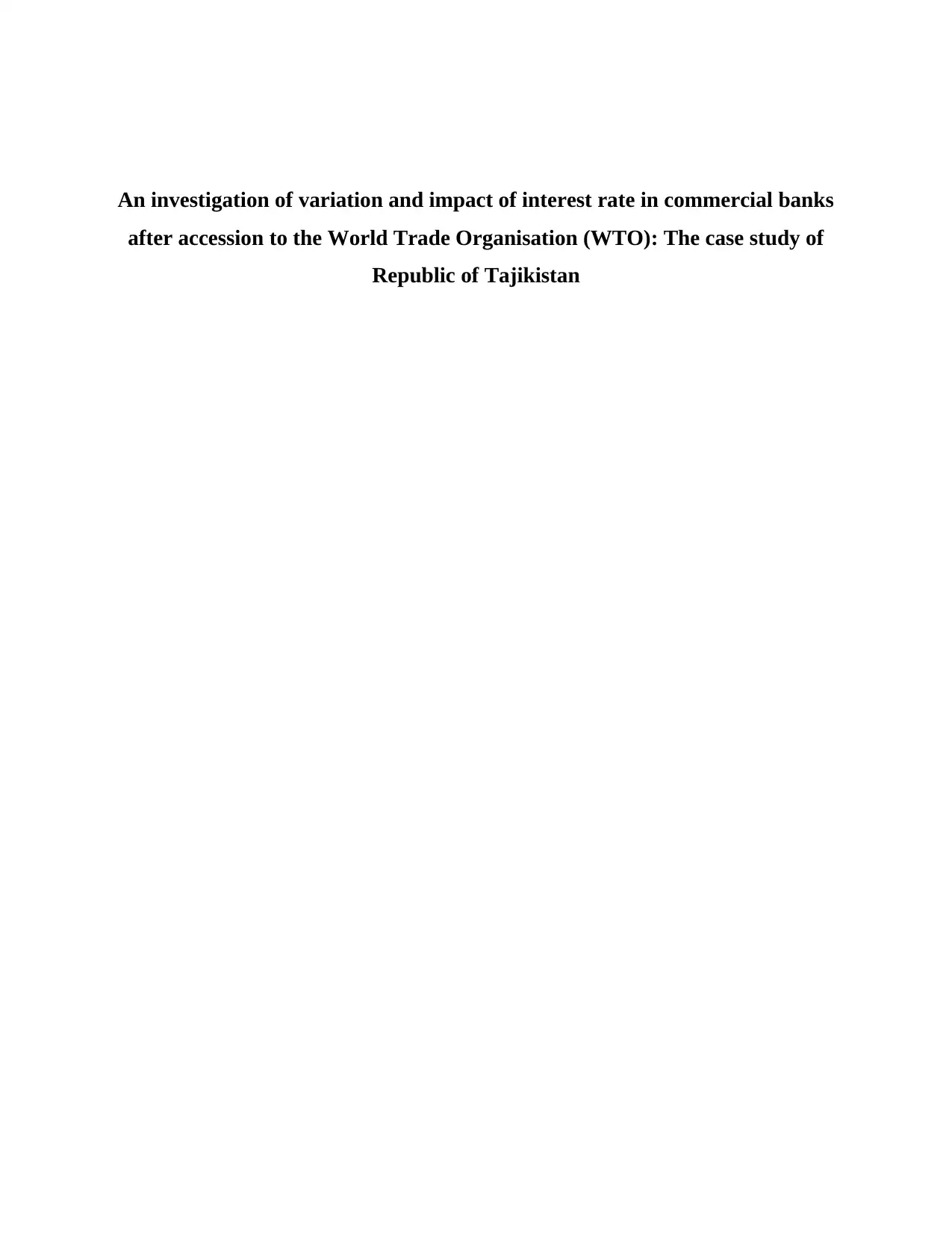
An investigation of variation and impact of interest rate in commercial banks
after accession to the World Trade Organisation (WTO): The case study of
Republic of Tajikistan
after accession to the World Trade Organisation (WTO): The case study of
Republic of Tajikistan
Paraphrase This Document
Need a fresh take? Get an instant paraphrase of this document with our AI Paraphraser
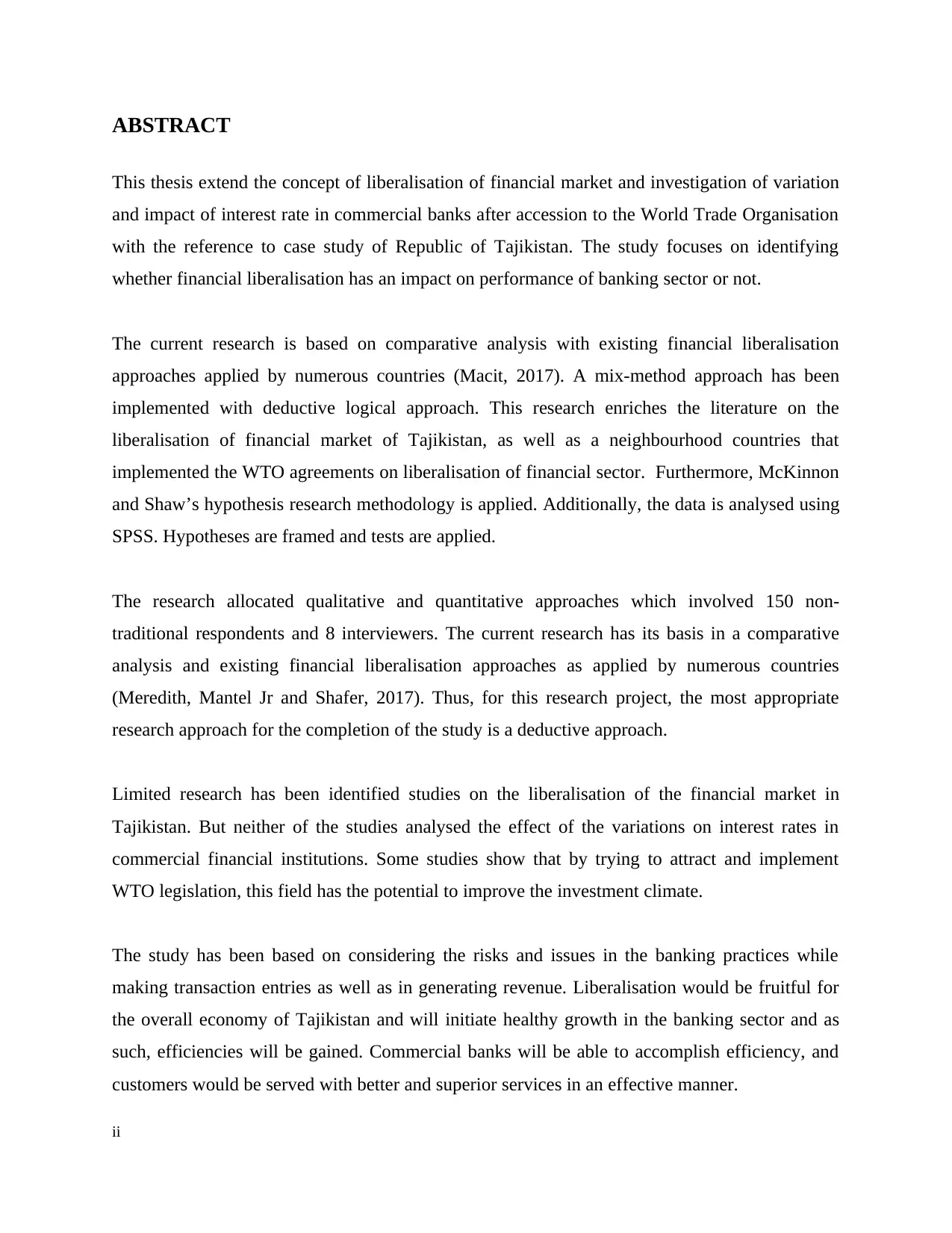
ABSTRACT
This thesis extend the concept of liberalisation of financial market and investigation of variation
and impact of interest rate in commercial banks after accession to the World Trade Organisation
with the reference to case study of Republic of Tajikistan. The study focuses on identifying
whether financial liberalisation has an impact on performance of banking sector or not.
The current research is based on comparative analysis with existing financial liberalisation
approaches applied by numerous countries (Macit, 2017). A mix-method approach has been
implemented with deductive logical approach. This research enriches the literature on the
liberalisation of financial market of Tajikistan, as well as a neighbourhood countries that
implemented the WTO agreements on liberalisation of financial sector. Furthermore, McKinnon
and Shaw’s hypothesis research methodology is applied. Additionally, the data is analysed using
SPSS. Hypotheses are framed and tests are applied.
The research allocated qualitative and quantitative approaches which involved 150 non-
traditional respondents and 8 interviewers. The current research has its basis in a comparative
analysis and existing financial liberalisation approaches as applied by numerous countries
(Meredith, Mantel Jr and Shafer, 2017). Thus, for this research project, the most appropriate
research approach for the completion of the study is a deductive approach.
Limited research has been identified studies on the liberalisation of the financial market in
Tajikistan. But neither of the studies analysed the effect of the variations on interest rates in
commercial financial institutions. Some studies show that by trying to attract and implement
WTO legislation, this field has the potential to improve the investment climate.
The study has been based on considering the risks and issues in the banking practices while
making transaction entries as well as in generating revenue. Liberalisation would be fruitful for
the overall economy of Tajikistan and will initiate healthy growth in the banking sector and as
such, efficiencies will be gained. Commercial banks will be able to accomplish efficiency, and
customers would be served with better and superior services in an effective manner.
ii
This thesis extend the concept of liberalisation of financial market and investigation of variation
and impact of interest rate in commercial banks after accession to the World Trade Organisation
with the reference to case study of Republic of Tajikistan. The study focuses on identifying
whether financial liberalisation has an impact on performance of banking sector or not.
The current research is based on comparative analysis with existing financial liberalisation
approaches applied by numerous countries (Macit, 2017). A mix-method approach has been
implemented with deductive logical approach. This research enriches the literature on the
liberalisation of financial market of Tajikistan, as well as a neighbourhood countries that
implemented the WTO agreements on liberalisation of financial sector. Furthermore, McKinnon
and Shaw’s hypothesis research methodology is applied. Additionally, the data is analysed using
SPSS. Hypotheses are framed and tests are applied.
The research allocated qualitative and quantitative approaches which involved 150 non-
traditional respondents and 8 interviewers. The current research has its basis in a comparative
analysis and existing financial liberalisation approaches as applied by numerous countries
(Meredith, Mantel Jr and Shafer, 2017). Thus, for this research project, the most appropriate
research approach for the completion of the study is a deductive approach.
Limited research has been identified studies on the liberalisation of the financial market in
Tajikistan. But neither of the studies analysed the effect of the variations on interest rates in
commercial financial institutions. Some studies show that by trying to attract and implement
WTO legislation, this field has the potential to improve the investment climate.
The study has been based on considering the risks and issues in the banking practices while
making transaction entries as well as in generating revenue. Liberalisation would be fruitful for
the overall economy of Tajikistan and will initiate healthy growth in the banking sector and as
such, efficiencies will be gained. Commercial banks will be able to accomplish efficiency, and
customers would be served with better and superior services in an effective manner.
ii
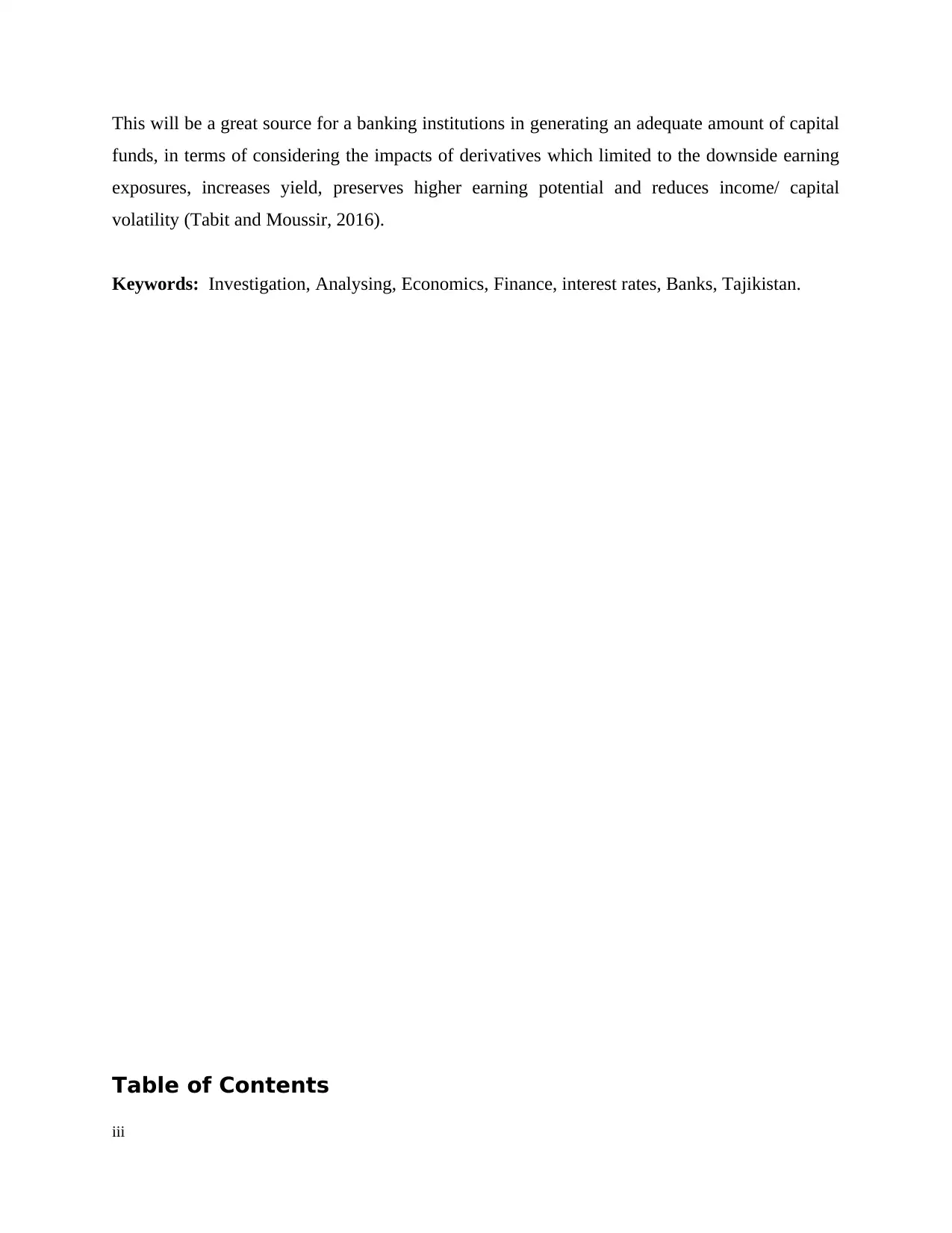
This will be a great source for a banking institutions in generating an adequate amount of capital
funds, in terms of considering the impacts of derivatives which limited to the downside earning
exposures, increases yield, preserves higher earning potential and reduces income/ capital
volatility (Tabit and Moussir, 2016).
Keywords: Investigation, Analysing, Economics, Finance, interest rates, Banks, Tajikistan.
Table of Contents
iii
funds, in terms of considering the impacts of derivatives which limited to the downside earning
exposures, increases yield, preserves higher earning potential and reduces income/ capital
volatility (Tabit and Moussir, 2016).
Keywords: Investigation, Analysing, Economics, Finance, interest rates, Banks, Tajikistan.
Table of Contents
iii
⊘ This is a preview!⊘
Do you want full access?
Subscribe today to unlock all pages.

Trusted by 1+ million students worldwide
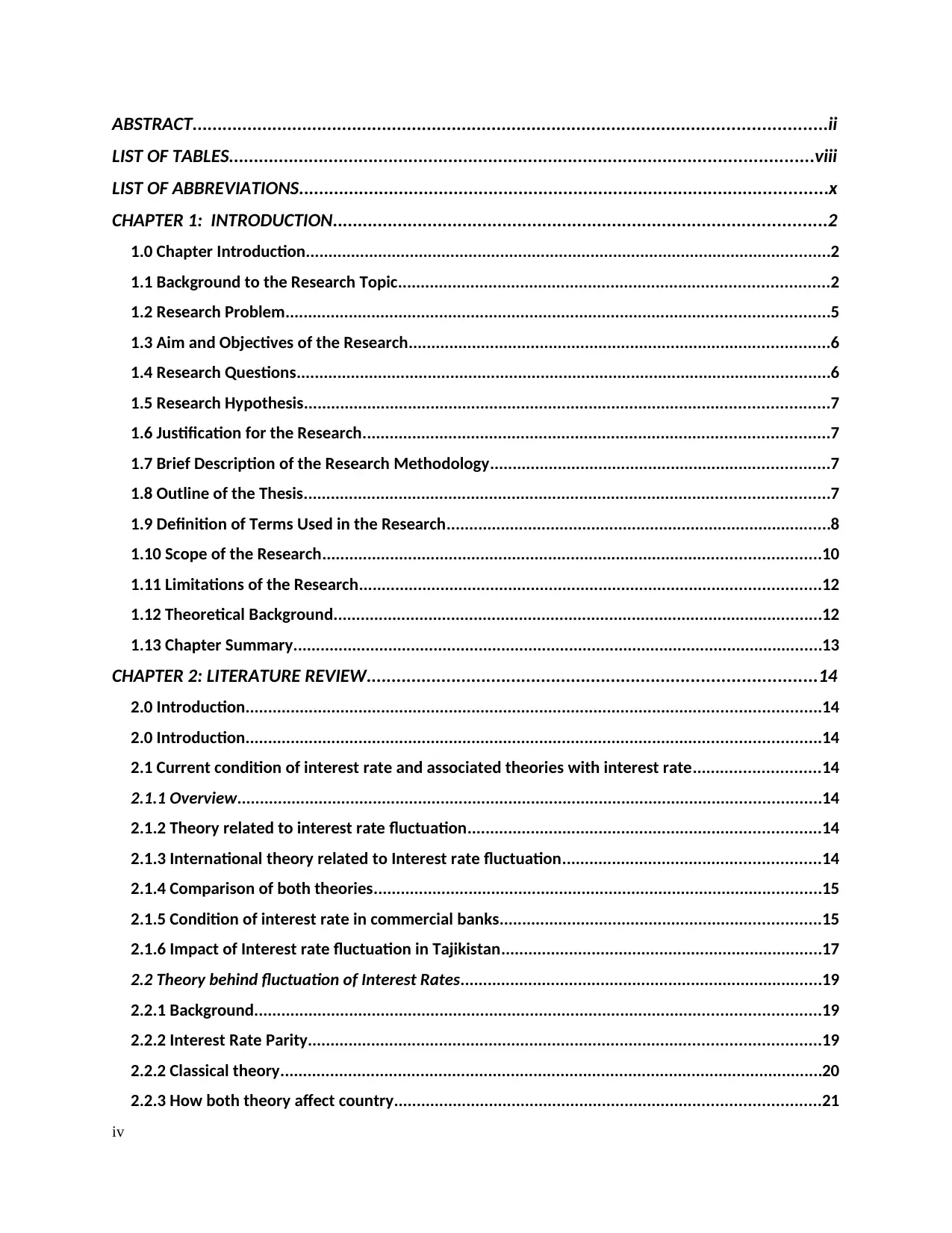
ABSTRACT...............................................................................................................................ii
LIST OF TABLES.....................................................................................................................viii
LIST OF ABBREVIATIONS..........................................................................................................x
CHAPTER 1: INTRODUCTION...................................................................................................2
1.0 Chapter Introduction....................................................................................................................2
1.1 Background to the Research Topic...............................................................................................2
1.2 Research Problem........................................................................................................................5
1.3 Aim and Objectives of the Research.............................................................................................6
1.4 Research Questions......................................................................................................................6
1.5 Research Hypothesis....................................................................................................................7
1.6 Justification for the Research.......................................................................................................7
1.7 Brief Description of the Research Methodology...........................................................................7
1.8 Outline of the Thesis....................................................................................................................7
1.9 Definition of Terms Used in the Research.....................................................................................8
1.10 Scope of the Research..............................................................................................................10
1.11 Limitations of the Research......................................................................................................12
1.12 Theoretical Background............................................................................................................12
1.13 Chapter Summary.....................................................................................................................13
CHAPTER 2: LITERATURE REVIEW..........................................................................................14
2.0 Introduction...............................................................................................................................14
2.0 Introduction...............................................................................................................................14
2.1 Current condition of interest rate and associated theories with interest rate............................14
2.1.1 Overview.................................................................................................................................14
2.1.2 Theory related to interest rate fluctuation..............................................................................14
2.1.3 International theory related to Interest rate fluctuation.........................................................14
2.1.4 Comparison of both theories...................................................................................................15
2.1.5 Condition of interest rate in commercial banks.......................................................................15
2.1.6 Impact of Interest rate fluctuation in Tajikistan.......................................................................17
2.2 Theory behind fluctuation of Interest Rates................................................................................19
2.2.1 Background.............................................................................................................................19
2.2.2 Interest Rate Parity.................................................................................................................19
2.2.2 Classical theory........................................................................................................................20
2.2.3 How both theory affect country..............................................................................................21
iv
LIST OF TABLES.....................................................................................................................viii
LIST OF ABBREVIATIONS..........................................................................................................x
CHAPTER 1: INTRODUCTION...................................................................................................2
1.0 Chapter Introduction....................................................................................................................2
1.1 Background to the Research Topic...............................................................................................2
1.2 Research Problem........................................................................................................................5
1.3 Aim and Objectives of the Research.............................................................................................6
1.4 Research Questions......................................................................................................................6
1.5 Research Hypothesis....................................................................................................................7
1.6 Justification for the Research.......................................................................................................7
1.7 Brief Description of the Research Methodology...........................................................................7
1.8 Outline of the Thesis....................................................................................................................7
1.9 Definition of Terms Used in the Research.....................................................................................8
1.10 Scope of the Research..............................................................................................................10
1.11 Limitations of the Research......................................................................................................12
1.12 Theoretical Background............................................................................................................12
1.13 Chapter Summary.....................................................................................................................13
CHAPTER 2: LITERATURE REVIEW..........................................................................................14
2.0 Introduction...............................................................................................................................14
2.0 Introduction...............................................................................................................................14
2.1 Current condition of interest rate and associated theories with interest rate............................14
2.1.1 Overview.................................................................................................................................14
2.1.2 Theory related to interest rate fluctuation..............................................................................14
2.1.3 International theory related to Interest rate fluctuation.........................................................14
2.1.4 Comparison of both theories...................................................................................................15
2.1.5 Condition of interest rate in commercial banks.......................................................................15
2.1.6 Impact of Interest rate fluctuation in Tajikistan.......................................................................17
2.2 Theory behind fluctuation of Interest Rates................................................................................19
2.2.1 Background.............................................................................................................................19
2.2.2 Interest Rate Parity.................................................................................................................19
2.2.2 Classical theory........................................................................................................................20
2.2.3 How both theory affect country..............................................................................................21
iv
Paraphrase This Document
Need a fresh take? Get an instant paraphrase of this document with our AI Paraphraser
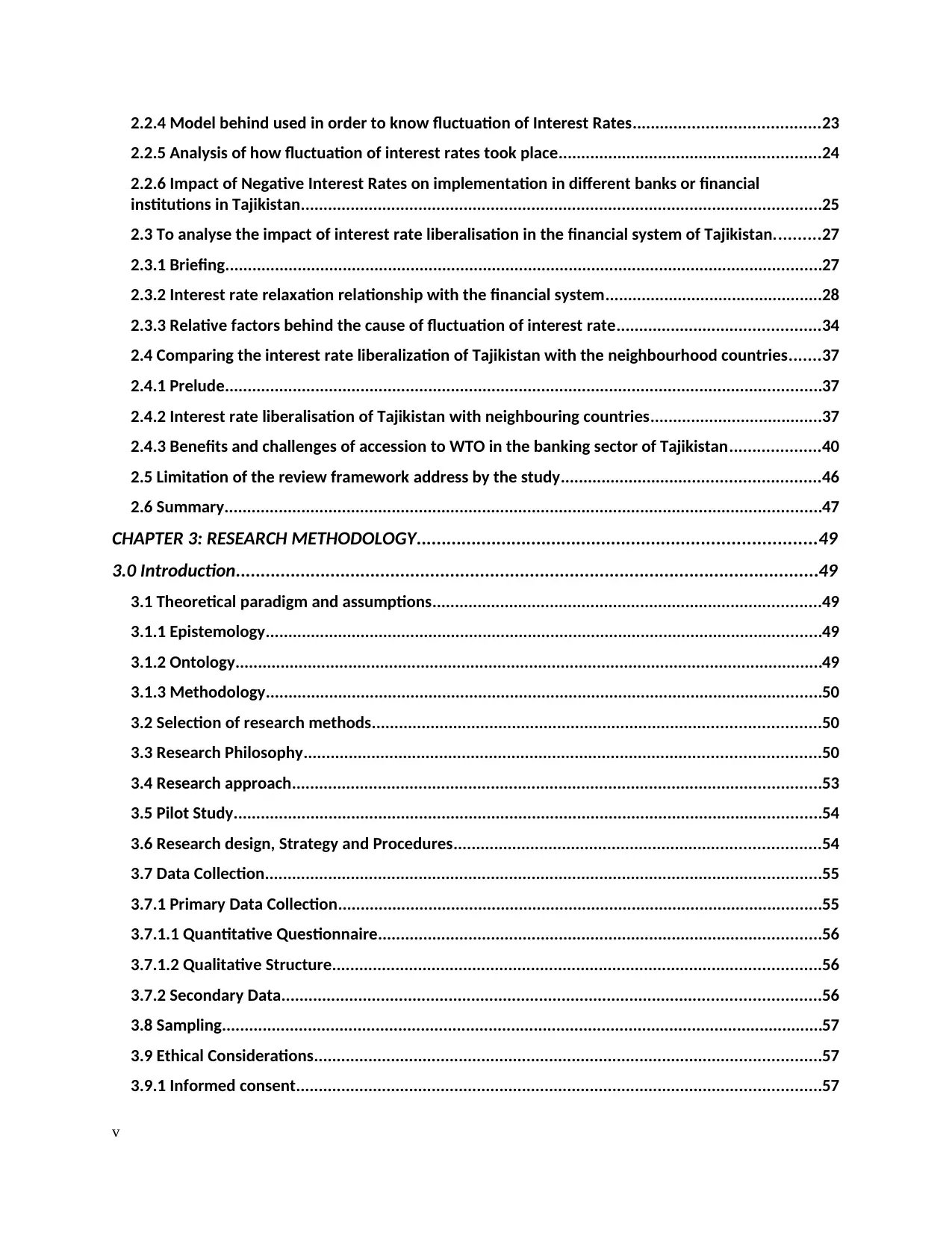
2.2.4 Model behind used in order to know fluctuation of Interest Rates.........................................23
2.2.5 Analysis of how fluctuation of interest rates took place..........................................................24
2.2.6 Impact of Negative Interest Rates on implementation in different banks or financial
institutions in Tajikistan...................................................................................................................25
2.3 To analyse the impact of interest rate liberalisation in the financial system of Tajikistan..........27
2.3.1 Briefing....................................................................................................................................27
2.3.2 Interest rate relaxation relationship with the financial system................................................28
2.3.3 Relative factors behind the cause of fluctuation of interest rate.............................................34
2.4 Comparing the interest rate liberalization of Tajikistan with the neighbourhood countries.......37
2.4.1 Prelude....................................................................................................................................37
2.4.2 Interest rate liberalisation of Tajikistan with neighbouring countries......................................37
2.4.3 Benefits and challenges of accession to WTO in the banking sector of Tajikistan....................40
2.5 Limitation of the review framework address by the study.........................................................46
2.6 Summary....................................................................................................................................47
CHAPTER 3: RESEARCH METHODOLOGY................................................................................49
3.0 Introduction.....................................................................................................................49
3.1 Theoretical paradigm and assumptions......................................................................................49
3.1.1 Epistemology...........................................................................................................................49
3.1.2 Ontology..................................................................................................................................49
3.1.3 Methodology...........................................................................................................................50
3.2 Selection of research methods...................................................................................................50
3.3 Research Philosophy..................................................................................................................50
3.4 Research approach.....................................................................................................................53
3.5 Pilot Study..................................................................................................................................54
3.6 Research design, Strategy and Procedures.................................................................................54
3.7 Data Collection...........................................................................................................................55
3.7.1 Primary Data Collection...........................................................................................................55
3.7.1.1 Quantitative Questionnaire..................................................................................................56
3.7.1.2 Qualitative Structure............................................................................................................56
3.7.2 Secondary Data.......................................................................................................................56
3.8 Sampling.....................................................................................................................................57
3.9 Ethical Considerations................................................................................................................57
3.9.1 Informed consent....................................................................................................................57
v
2.2.5 Analysis of how fluctuation of interest rates took place..........................................................24
2.2.6 Impact of Negative Interest Rates on implementation in different banks or financial
institutions in Tajikistan...................................................................................................................25
2.3 To analyse the impact of interest rate liberalisation in the financial system of Tajikistan..........27
2.3.1 Briefing....................................................................................................................................27
2.3.2 Interest rate relaxation relationship with the financial system................................................28
2.3.3 Relative factors behind the cause of fluctuation of interest rate.............................................34
2.4 Comparing the interest rate liberalization of Tajikistan with the neighbourhood countries.......37
2.4.1 Prelude....................................................................................................................................37
2.4.2 Interest rate liberalisation of Tajikistan with neighbouring countries......................................37
2.4.3 Benefits and challenges of accession to WTO in the banking sector of Tajikistan....................40
2.5 Limitation of the review framework address by the study.........................................................46
2.6 Summary....................................................................................................................................47
CHAPTER 3: RESEARCH METHODOLOGY................................................................................49
3.0 Introduction.....................................................................................................................49
3.1 Theoretical paradigm and assumptions......................................................................................49
3.1.1 Epistemology...........................................................................................................................49
3.1.2 Ontology..................................................................................................................................49
3.1.3 Methodology...........................................................................................................................50
3.2 Selection of research methods...................................................................................................50
3.3 Research Philosophy..................................................................................................................50
3.4 Research approach.....................................................................................................................53
3.5 Pilot Study..................................................................................................................................54
3.6 Research design, Strategy and Procedures.................................................................................54
3.7 Data Collection...........................................................................................................................55
3.7.1 Primary Data Collection...........................................................................................................55
3.7.1.1 Quantitative Questionnaire..................................................................................................56
3.7.1.2 Qualitative Structure............................................................................................................56
3.7.2 Secondary Data.......................................................................................................................56
3.8 Sampling.....................................................................................................................................57
3.9 Ethical Considerations................................................................................................................57
3.9.1 Informed consent....................................................................................................................57
v
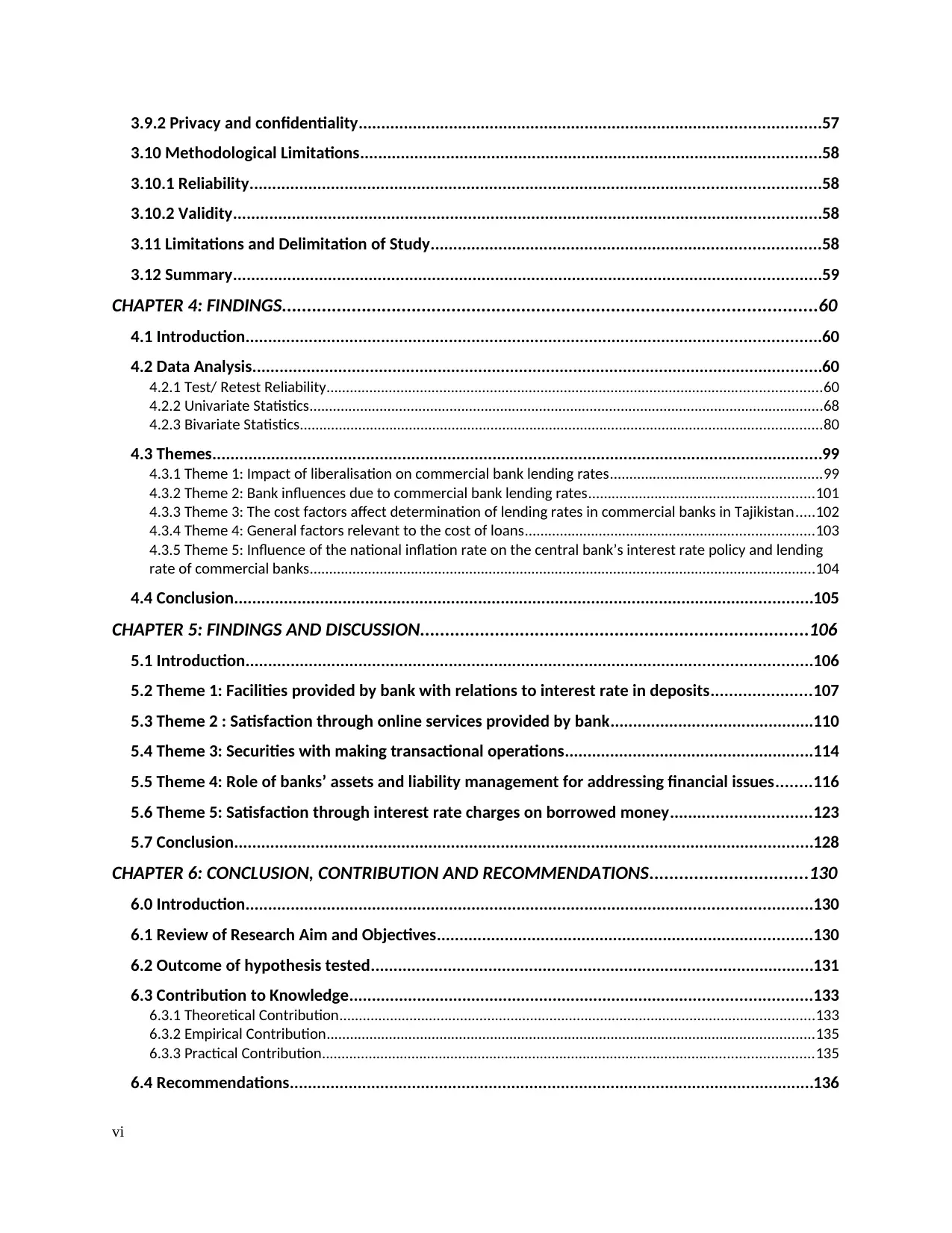
3.9.2 Privacy and confidentiality......................................................................................................57
3.10 Methodological Limitations......................................................................................................58
3.10.1 Reliability..............................................................................................................................58
3.10.2 Validity..................................................................................................................................58
3.11 Limitations and Delimitation of Study......................................................................................58
3.12 Summary..................................................................................................................................59
CHAPTER 4: FINDINGS...........................................................................................................60
4.1 Introduction...............................................................................................................................60
4.2 Data Analysis..............................................................................................................................60
4.2.1 Test/ Retest Reliability...............................................................................................................................60
4.2.2 Univariate Statistics....................................................................................................................................68
4.2.3 Bivariate Statistics......................................................................................................................................80
4.3 Themes.......................................................................................................................................99
4.3.1 Theme 1: Impact of liberalisation on commercial bank lending rates......................................................99
4.3.2 Theme 2: Bank influences due to commercial bank lending rates..........................................................101
4.3.3 Theme 3: The cost factors affect determination of lending rates in commercial banks in Tajikistan.....102
4.3.4 Theme 4: General factors relevant to the cost of loans..........................................................................103
4.3.5 Theme 5: Influence of the national inflation rate on the central bank’s interest rate policy and lending
rate of commercial banks..................................................................................................................................104
4.4 Conclusion................................................................................................................................105
CHAPTER 5: FINDINGS AND DISCUSSION..............................................................................106
5.1 Introduction.............................................................................................................................106
5.2 Theme 1: Facilities provided by bank with relations to interest rate in deposits......................107
5.3 Theme 2 : Satisfaction through online services provided by bank.............................................110
5.4 Theme 3: Securities with making transactional operations.......................................................114
5.5 Theme 4: Role of banks’ assets and liability management for addressing financial issues........116
5.6 Theme 5: Satisfaction through interest rate charges on borrowed money...............................123
5.7 Conclusion................................................................................................................................128
CHAPTER 6: CONCLUSION, CONTRIBUTION AND RECOMMENDATIONS................................130
6.0 Introduction.............................................................................................................................130
6.1 Review of Research Aim and Objectives...................................................................................130
6.2 Outcome of hypothesis tested..................................................................................................131
6.3 Contribution to Knowledge......................................................................................................133
6.3.1 Theoretical Contribution..........................................................................................................................133
6.3.2 Empirical Contribution.............................................................................................................................135
6.3.3 Practical Contribution..............................................................................................................................135
6.4 Recommendations....................................................................................................................136
vi
3.10 Methodological Limitations......................................................................................................58
3.10.1 Reliability..............................................................................................................................58
3.10.2 Validity..................................................................................................................................58
3.11 Limitations and Delimitation of Study......................................................................................58
3.12 Summary..................................................................................................................................59
CHAPTER 4: FINDINGS...........................................................................................................60
4.1 Introduction...............................................................................................................................60
4.2 Data Analysis..............................................................................................................................60
4.2.1 Test/ Retest Reliability...............................................................................................................................60
4.2.2 Univariate Statistics....................................................................................................................................68
4.2.3 Bivariate Statistics......................................................................................................................................80
4.3 Themes.......................................................................................................................................99
4.3.1 Theme 1: Impact of liberalisation on commercial bank lending rates......................................................99
4.3.2 Theme 2: Bank influences due to commercial bank lending rates..........................................................101
4.3.3 Theme 3: The cost factors affect determination of lending rates in commercial banks in Tajikistan.....102
4.3.4 Theme 4: General factors relevant to the cost of loans..........................................................................103
4.3.5 Theme 5: Influence of the national inflation rate on the central bank’s interest rate policy and lending
rate of commercial banks..................................................................................................................................104
4.4 Conclusion................................................................................................................................105
CHAPTER 5: FINDINGS AND DISCUSSION..............................................................................106
5.1 Introduction.............................................................................................................................106
5.2 Theme 1: Facilities provided by bank with relations to interest rate in deposits......................107
5.3 Theme 2 : Satisfaction through online services provided by bank.............................................110
5.4 Theme 3: Securities with making transactional operations.......................................................114
5.5 Theme 4: Role of banks’ assets and liability management for addressing financial issues........116
5.6 Theme 5: Satisfaction through interest rate charges on borrowed money...............................123
5.7 Conclusion................................................................................................................................128
CHAPTER 6: CONCLUSION, CONTRIBUTION AND RECOMMENDATIONS................................130
6.0 Introduction.............................................................................................................................130
6.1 Review of Research Aim and Objectives...................................................................................130
6.2 Outcome of hypothesis tested..................................................................................................131
6.3 Contribution to Knowledge......................................................................................................133
6.3.1 Theoretical Contribution..........................................................................................................................133
6.3.2 Empirical Contribution.............................................................................................................................135
6.3.3 Practical Contribution..............................................................................................................................135
6.4 Recommendations....................................................................................................................136
vi
⊘ This is a preview!⊘
Do you want full access?
Subscribe today to unlock all pages.

Trusted by 1+ million students worldwide
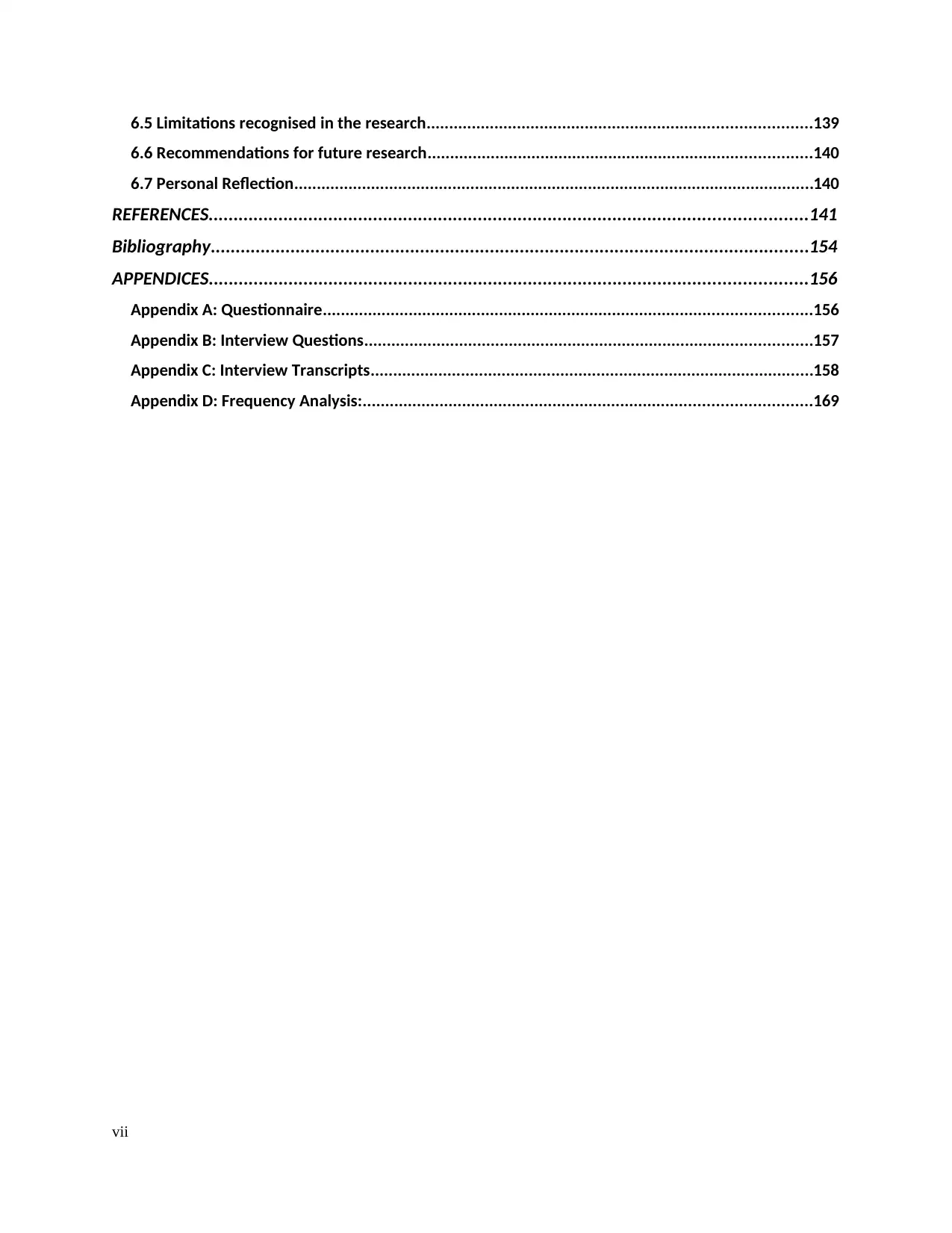
6.5 Limitations recognised in the research.....................................................................................139
6.6 Recommendations for future research.....................................................................................140
6.7 Personal Reflection...................................................................................................................140
REFERENCES........................................................................................................................141
Bibliography........................................................................................................................154
APPENDICES........................................................................................................................156
Appendix A: Questionnaire............................................................................................................156
Appendix B: Interview Questions...................................................................................................157
Appendix C: Interview Transcripts..................................................................................................158
Appendix D: Frequency Analysis:...................................................................................................169
vii
6.6 Recommendations for future research.....................................................................................140
6.7 Personal Reflection...................................................................................................................140
REFERENCES........................................................................................................................141
Bibliography........................................................................................................................154
APPENDICES........................................................................................................................156
Appendix A: Questionnaire............................................................................................................156
Appendix B: Interview Questions...................................................................................................157
Appendix C: Interview Transcripts..................................................................................................158
Appendix D: Frequency Analysis:...................................................................................................169
vii
Paraphrase This Document
Need a fresh take? Get an instant paraphrase of this document with our AI Paraphraser
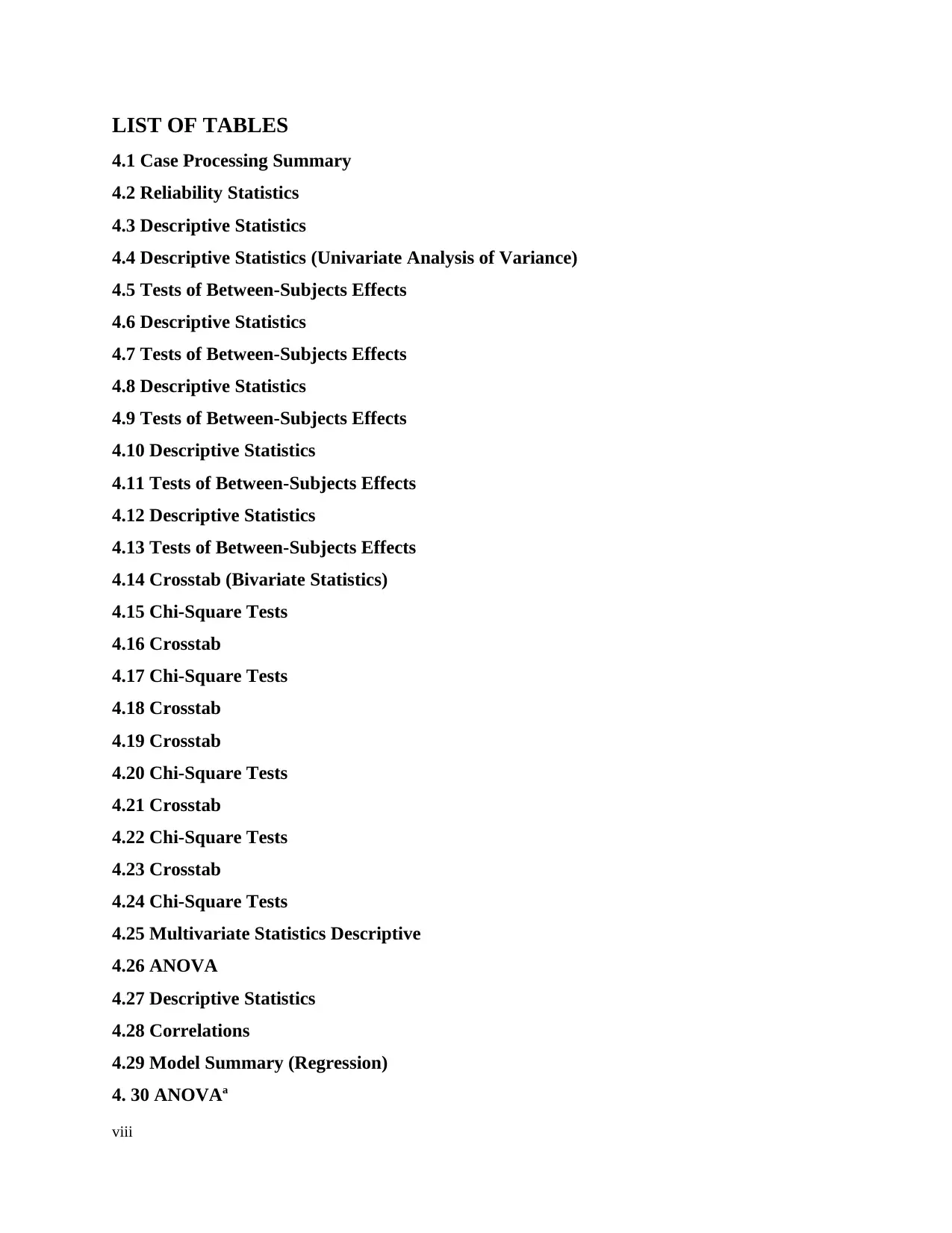
LIST OF TABLES
4.1 Case Processing Summary
4.2 Reliability Statistics
4.3 Descriptive Statistics
4.4 Descriptive Statistics (Univariate Analysis of Variance)
4.5 Tests of Between-Subjects Effects
4.6 Descriptive Statistics
4.7 Tests of Between-Subjects Effects
4.8 Descriptive Statistics
4.9 Tests of Between-Subjects Effects
4.10 Descriptive Statistics
4.11 Tests of Between-Subjects Effects
4.12 Descriptive Statistics
4.13 Tests of Between-Subjects Effects
4.14 Crosstab (Bivariate Statistics)
4.15 Chi-Square Tests
4.16 Crosstab
4.17 Chi-Square Tests
4.18 Crosstab
4.19 Crosstab
4.20 Chi-Square Tests
4.21 Crosstab
4.22 Chi-Square Tests
4.23 Crosstab
4.24 Chi-Square Tests
4.25 Multivariate Statistics Descriptive
4.26 ANOVA
4.27 Descriptive Statistics
4.28 Correlations
4.29 Model Summary (Regression)
4. 30 ANOVAa
viii
4.1 Case Processing Summary
4.2 Reliability Statistics
4.3 Descriptive Statistics
4.4 Descriptive Statistics (Univariate Analysis of Variance)
4.5 Tests of Between-Subjects Effects
4.6 Descriptive Statistics
4.7 Tests of Between-Subjects Effects
4.8 Descriptive Statistics
4.9 Tests of Between-Subjects Effects
4.10 Descriptive Statistics
4.11 Tests of Between-Subjects Effects
4.12 Descriptive Statistics
4.13 Tests of Between-Subjects Effects
4.14 Crosstab (Bivariate Statistics)
4.15 Chi-Square Tests
4.16 Crosstab
4.17 Chi-Square Tests
4.18 Crosstab
4.19 Crosstab
4.20 Chi-Square Tests
4.21 Crosstab
4.22 Chi-Square Tests
4.23 Crosstab
4.24 Chi-Square Tests
4.25 Multivariate Statistics Descriptive
4.26 ANOVA
4.27 Descriptive Statistics
4.28 Correlations
4.29 Model Summary (Regression)
4. 30 ANOVAa
viii

4.31 Coefficientsa
4.32 Excluded Variablesa
4.33 Collinearity Diagnosticsa
ix
4.32 Excluded Variablesa
4.33 Collinearity Diagnosticsa
ix
⊘ This is a preview!⊘
Do you want full access?
Subscribe today to unlock all pages.

Trusted by 1+ million students worldwide
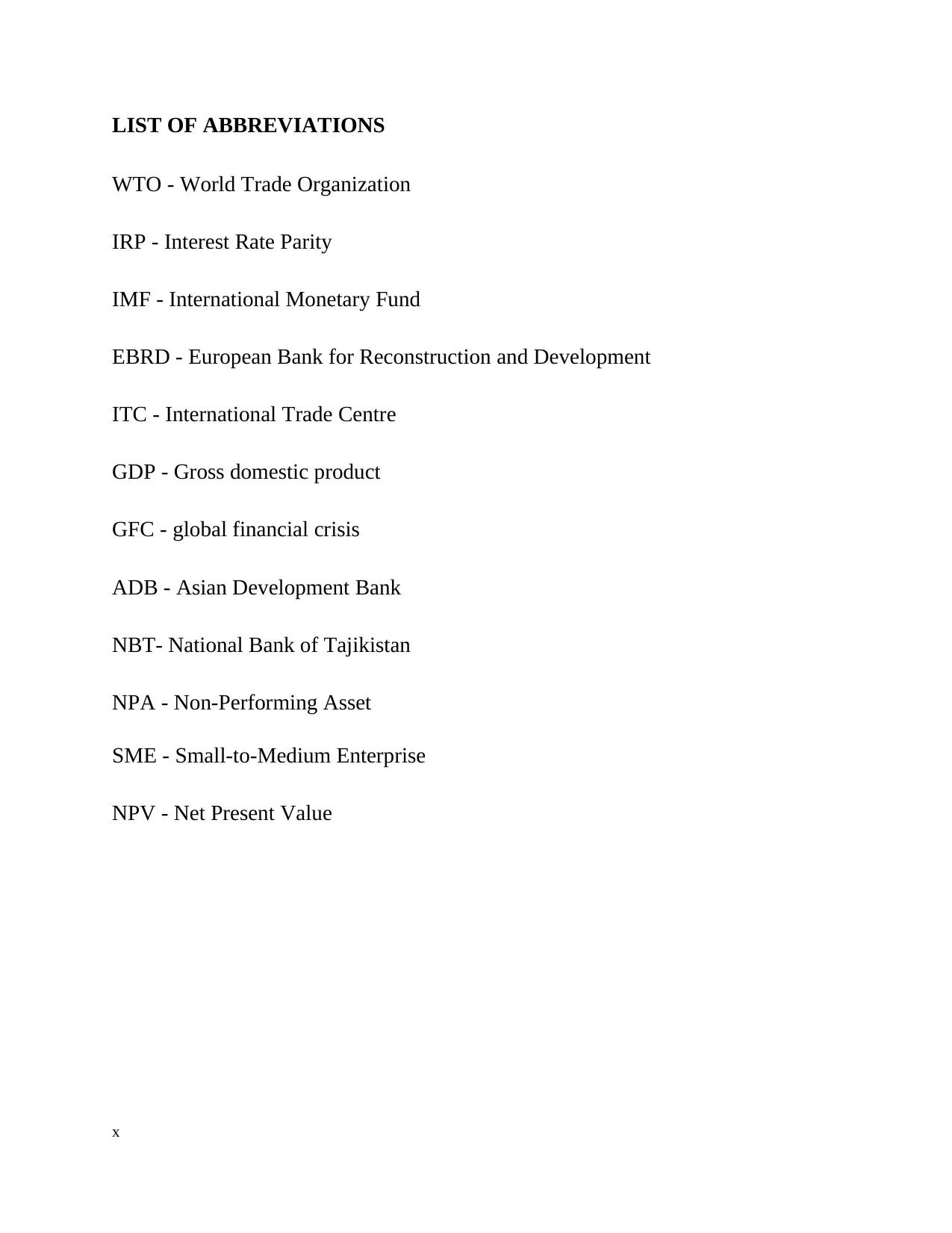
LIST OF ABBREVIATIONS
WTO - World Trade Organization
IRP - Interest Rate Parity
IMF - International Monetary Fund
EBRD - European Bank for Reconstruction and Development
ITC - International Trade Centre
GDP - Gross domestic product
GFC - global financial crisis
ADB - Asian Development Bank
NBT- National Bank of Tajikistan
NPA - Non-Performing Asset
SME - Small-to-Medium Enterprise
NPV - Net Present Value
x
WTO - World Trade Organization
IRP - Interest Rate Parity
IMF - International Monetary Fund
EBRD - European Bank for Reconstruction and Development
ITC - International Trade Centre
GDP - Gross domestic product
GFC - global financial crisis
ADB - Asian Development Bank
NBT- National Bank of Tajikistan
NPA - Non-Performing Asset
SME - Small-to-Medium Enterprise
NPV - Net Present Value
x
Paraphrase This Document
Need a fresh take? Get an instant paraphrase of this document with our AI Paraphraser

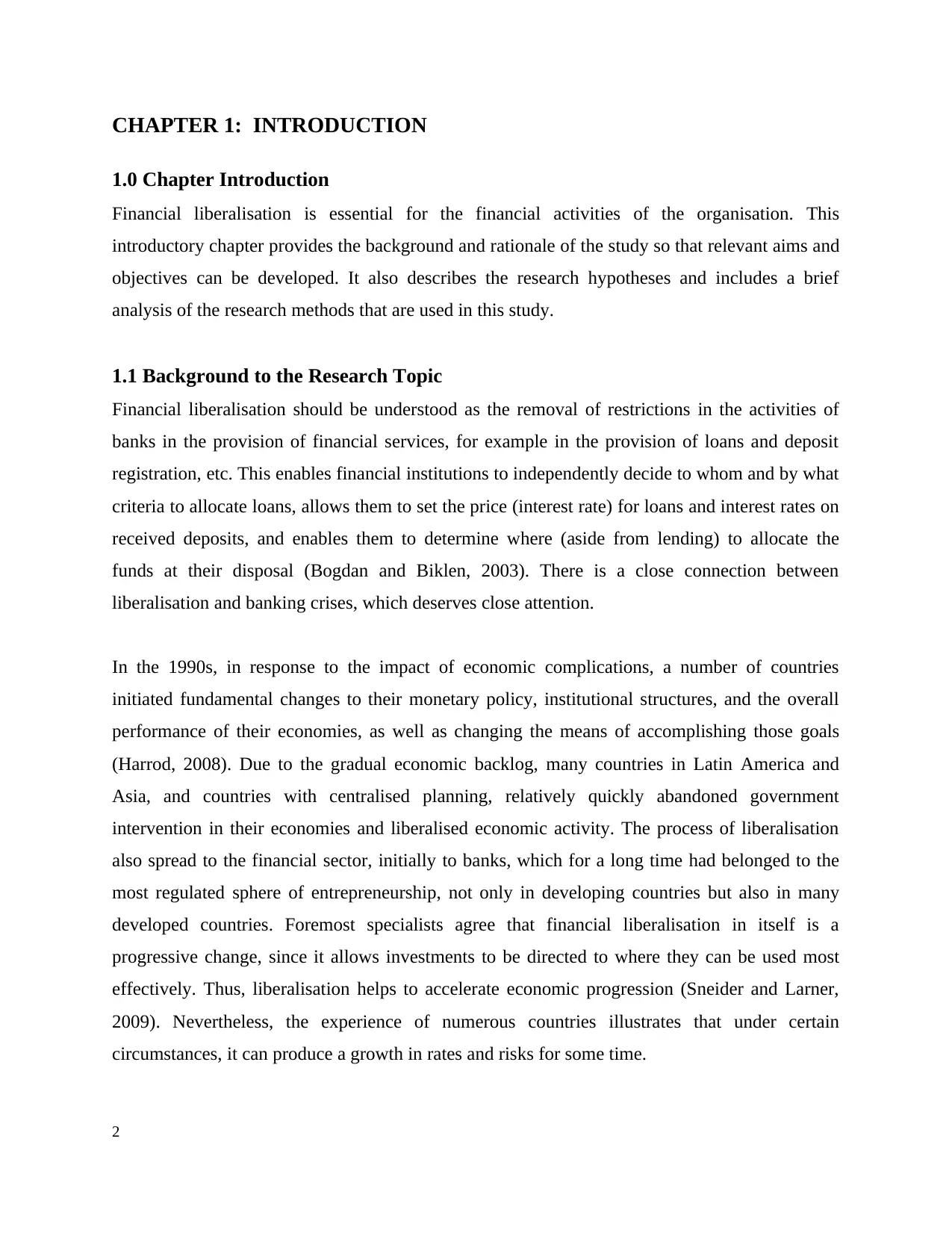
CHAPTER 1: INTRODUCTION
1.0 Chapter Introduction
Financial liberalisation is essential for the financial activities of the organisation. This
introductory chapter provides the background and rationale of the study so that relevant aims and
objectives can be developed. It also describes the research hypotheses and includes a brief
analysis of the research methods that are used in this study.
1.1 Background to the Research Topic
Financial liberalisation should be understood as the removal of restrictions in the activities of
banks in the provision of financial services, for example in the provision of loans and deposit
registration, etc. This enables financial institutions to independently decide to whom and by what
criteria to allocate loans, allows them to set the price (interest rate) for loans and interest rates on
received deposits, and enables them to determine where (aside from lending) to allocate the
funds at their disposal (Bogdan and Biklen, 2003). There is a close connection between
liberalisation and banking crises, which deserves close attention.
In the 1990s, in response to the impact of economic complications, a number of countries
initiated fundamental changes to their monetary policy, institutional structures, and the overall
performance of their economies, as well as changing the means of accomplishing those goals
(Harrod, 2008). Due to the gradual economic backlog, many countries in Latin America and
Asia, and countries with centralised planning, relatively quickly abandoned government
intervention in their economies and liberalised economic activity. The process of liberalisation
also spread to the financial sector, initially to banks, which for a long time had belonged to the
most regulated sphere of entrepreneurship, not only in developing countries but also in many
developed countries. Foremost specialists agree that financial liberalisation in itself is a
progressive change, since it allows investments to be directed to where they can be used most
effectively. Thus, liberalisation helps to accelerate economic progression (Sneider and Larner,
2009). Nevertheless, the experience of numerous countries illustrates that under certain
circumstances, it can produce a growth in rates and risks for some time.
2
1.0 Chapter Introduction
Financial liberalisation is essential for the financial activities of the organisation. This
introductory chapter provides the background and rationale of the study so that relevant aims and
objectives can be developed. It also describes the research hypotheses and includes a brief
analysis of the research methods that are used in this study.
1.1 Background to the Research Topic
Financial liberalisation should be understood as the removal of restrictions in the activities of
banks in the provision of financial services, for example in the provision of loans and deposit
registration, etc. This enables financial institutions to independently decide to whom and by what
criteria to allocate loans, allows them to set the price (interest rate) for loans and interest rates on
received deposits, and enables them to determine where (aside from lending) to allocate the
funds at their disposal (Bogdan and Biklen, 2003). There is a close connection between
liberalisation and banking crises, which deserves close attention.
In the 1990s, in response to the impact of economic complications, a number of countries
initiated fundamental changes to their monetary policy, institutional structures, and the overall
performance of their economies, as well as changing the means of accomplishing those goals
(Harrod, 2008). Due to the gradual economic backlog, many countries in Latin America and
Asia, and countries with centralised planning, relatively quickly abandoned government
intervention in their economies and liberalised economic activity. The process of liberalisation
also spread to the financial sector, initially to banks, which for a long time had belonged to the
most regulated sphere of entrepreneurship, not only in developing countries but also in many
developed countries. Foremost specialists agree that financial liberalisation in itself is a
progressive change, since it allows investments to be directed to where they can be used most
effectively. Thus, liberalisation helps to accelerate economic progression (Sneider and Larner,
2009). Nevertheless, the experience of numerous countries illustrates that under certain
circumstances, it can produce a growth in rates and risks for some time.
2
⊘ This is a preview!⊘
Do you want full access?
Subscribe today to unlock all pages.

Trusted by 1+ million students worldwide
1 out of 185
Related Documents
Your All-in-One AI-Powered Toolkit for Academic Success.
+13062052269
info@desklib.com
Available 24*7 on WhatsApp / Email
![[object Object]](/_next/static/media/star-bottom.7253800d.svg)
Unlock your academic potential
Copyright © 2020–2025 A2Z Services. All Rights Reserved. Developed and managed by ZUCOL.





